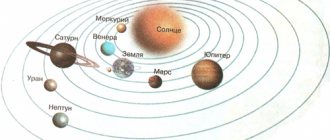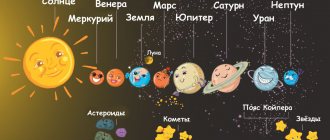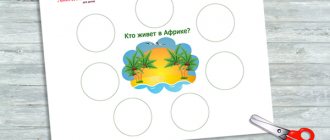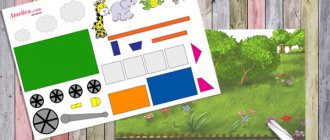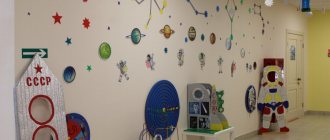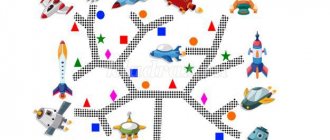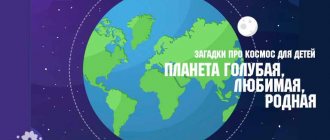Presentation for children “Space for children”
Presentation on the topic: Space for children
Download this presentation
Download this presentation
Slide No. 1 Slide description:
“Space for children” Purpose: To activate and stimulate the speech and thinking activity of children with mental retardation using the presentation of the lesson: “Space for children.”
Slide No. 2 Slide description:
1. We live on planet Earth.
The earth is our home. The earth resembles the shape of a ball. Slide number 3 Slide description:
2. Earth is the only planet on which there is life (sun, air and water).
Sun, air and water are needed more and more than ever. Without water, the body becomes decrepit. The sun gives us strength. Well, the air, no matter where you are, provides food for the brain. So it pulls us out of the house along that path that is familiar to us. Coppices, forest, fields. We live, the earth is spinning! Slide No. 4 Slide description:
3. The sun gives us light and warmth.
3. The sun gives us light and warmth. Slide No. 5 Slide description:
4. Trees produce the oxygen we breathe.
Slide No. 6 Slide description:
5. Thanks to bodies of water, on planet Earth we can drink fresh water.
Slide number 7 Slide description:
6. Therefore, on planet Earth live: people, animals, birds, fish, insects.
Slide No. 8 Slide description:
7. The following grow on planet Earth: trees, flowers, berries, mushrooms, etc.
Slide No. 9 Slide description:
8. On planet Earth there are vast forests, grassy plains, high mountains, hot deserts.
Slide number 10 Slide description:
9. Most of the Earth is covered with water.
Slide number 11 Slide description:
10. Planet Earth is just a speck of dust in the vast black space.
10. Planet Earth is just a speck of dust in the vast black space. The planet does not stand still - it rotates around its axis and at the same time moves around the Sun. Slide number 12 Slide description:
11. Due to the rotation of the planet around its axis, a change occurs. 11. Due to the rotation of the planet around its axis, a change of day occurs (morning, afternoon, evening, night).
Slide number 13 Description of slide:
12. Due to the movement of the Earth around the Sun, the seasons change.
12. Due to the movement of the Earth around the Sun, the seasons change. A trip around the Sun takes the Earth one year. This is how the year begins and ends. How many months are there in a year? Slide number 14 Slide description:
13. The Earth turned around the Sun once - one year passed, then turned around a second time - the second year passed, the third, etc.
seventh... And you have grown over the years. 13. The Earth turned around the Sun once - one year passed, then turned around a second time - the second year passed, the third, etc. seventh... And you have grown over the years. Soon you will go to school... Thanks to the fact that you live on planet Earth, you have to go through your entire life path: from birth to old age. Slide number 15 Slide description:
“Count quickly” 5 years?
6 years? 7 years? -14- Slide No. 16 Slide description:
15. In the Universe, planet Earth is not alone (the Sun is a huge fiery 15. In the Universe, planet Earth is not alone (the Sun is a huge fiery star and 9 planets: Mercury, Venus, Earth, Mars, Jupiter, Saturn, Uranus
, Neptune
,
Pluto
) . flight of dogs: Belka and Strelka. After the flight, they returned safely to Earth. Slide No. 19 Slide description:
18. Yuri Alekseevich Gagarin. 18. Yuri Alekseevich Gagarin. He was the first cosmonaut to fly around the Earth on a spaceship (rocket).
Slide No. 20 Slide description:
19. Chief designer of the spacecraft (rocket) Sergei Pavlovich Korolev 19. Chief designer of the spacecraft (rocket) Sergei Pavlovich Korolev
Slide No. 21 Slide description:
20. To become an astronaut you need to study well, be literate, exercise and have good health.
This is how a medical examination is carried out before a flight into space. Slide number 22 Slide description:
21. This is how astronauts train and select those who will fly into space (smart, strong, physically tough, strong-willed, hardworking, resourceful).
Slide number 23 Slide description:
The first woman - cosmonaut The first woman - cosmonaut Valentina Tereshkova
Slide number 24 Slide description:
Cosmonaut on the Moon.
23. To work in space, you must have a special suit (space suit, overalls, shoes, etc.) Clothing must be comfortable and practical, with special equipment (walkie-talkie, life support system, etc.) Slide No. 25 Slide description:
24. In space, an astronaut must be prepared for weightlessness.
24. In space, an astronaut must be prepared for weightlessness. Slide number 26 Slide description:
25. This is how astronauts work in outer space (studying the planet, taking soil and dust samples; taking photographs, etc.).
25. This is how astronauts work in outer space (studying the planet, taking soil and dust samples; taking photographs, etc.). Slide number 27 Slide description:
26. Cosmonauts must be able to work on special installations.
The work of astronauts is difficult, responsible and dangerous. In space, astronauts conduct experiments: grow mushrooms and wheat; They gained experience in raising chickens in an incubator. 26. Cosmonauts must be able to work on special installations. The work of astronauts is difficult, responsible and dangerous. In space, astronauts conduct experiments: grow mushrooms and wheat; They gained experience in raising chickens in an incubator. Slide No. 28 Slide description:
27. The astronauts’ food is in tubes and vacuum packaging - in a liquid state..
Slide No. 29 Slide description:
28. This is how the astronauts relax and rejoice that their flight was successful.
That they returned to earth healthy and unharmed. 28. This is how the astronauts relax and rejoice that their flight was successful. That they returned to earth healthy and unharmed. Slide number 30 Slide description:
Space exploration by astronauts gives people on Earth the opportunity to: 3. Use navigators so that they can easily navigate the roads, etc.
-29- Slide No. 31 Slide description:
Congratulations!
You are awarded a diploma for mastering the course: “Space for Children” Slide No. 32 Slide description:
Thank you for your attention!
ppt4web.ru
Project "Cosmos"
Kindergarten preparatory group
Project content
Project name: "Space".
Project type : educational, creative, informational.
Duration : medium-term (1 month).
Content : research-creative, informational (practice-oriented).
By the nature of contacts : child-parent, within the preschool educational institution.
Participants: children of the preparatory group, teacher, parents.
Educational areas: “Cognitive development”, “Socio-communicative development”, “Speech development”, “Artistic and aesthetic development”, “Physical development”.
Problem: Arseny (pupil of group No. 2) brought an encyclopedia about space to the group. Looking at the illustrations in the encyclopedia, the children did not understand much. It turned out that preschoolers know little about the history of human space exploration and about outer space in general.
We tried to solve this problem using the project method. It is easier for children to understand complex material about space through a joint search for a solution to the problem with an adult (teacher or parents).
Relevance:
An important means of understanding the surrounding world is not only the surrounding nature, but also the unknown world of the Universe. It attracts his attention, forces him to include various senses in the process of observation, and therefore activates the initial moments of cognition - sensation and perception. Currently, it is necessary to form cognitive activity in children through various forms of activity: games, experiments, experiences, observations.
Curiosity and cognitive abilities do not arise on their own; they must be developed. Unfortunately, we noticed that in the “Origins” Program edited by L.A. Paramonov, T.I. Aliev, A.N. Davidchuk et al. in the preparatory group do not sufficiently cover the section “The World We Live In” on the topic “Space”, so there was a need to work on the “Space” project.
And we decided to organize the Cosmos project.” We believe that this methodological development will allow preschool children to develop an integrated picture of the world (an idea of outer space , the solar system and its planets, human space exploration ) , a sense of patriotism, pride and respect for their country.
Project goals: to create conditions for children to develop an idea of the world around them, so that the world becomes a source of knowledge and mental development of the child (an idea of outer space, the solar system and its planets, human space exploration); promote the development of cognitive and intellectual abilities of children together with parents (legal representatives).
Project objectives:
- To form and expand children’s ideas about the history of the development of astronautics;
- Form initial ideas about space, the solar system, planets, the diversity of outer space, etc.;
- To form children’s knowledge about the people who discovered space to humanity;
- To promote the formation in children of interest in space and its knowledge;
- Develop the creative abilities of preschoolers in various activities;
- Develop the skills to analyze, reason, generalize, compare, contrast, and draw conclusions;
- To cultivate respect for people who opened a “window” to space for humanity;
- Foster love for your country, feelings of patriotism and pride in the country.
For parents:
- Involving parents in the pedagogical process in preschool educational institutions, strengthening parents’ interest in cooperation with the kindergarten;
- Help parents establish emotional contact with their child, expanding the range of their nonverbal communication;
- Promote emotional bonding between parent and child.
Hypothesis:
During the implementation of the “Space” project, children of senior preschool age will form ideas about space; Concretizes knowledge about the planets of the solar system, constellations, meteorites, and generates interest in unknown facts from the history of space. Children will learn to analyze existing facts, establish cause-and-effect relationships, and draw conclusions.
This work will bring visible results provided that it is implemented in close cooperation between the family and the preschool educational institution.
Expected result:
- Children’s assimilation of knowledge and ideas about space (idea about outer space, the Solar system and its planets, human space exploration);
- Development of an active, independent, creative personality;
- Raising a patriotic feeling in a preschooler, the desire to be brave, strong and resilient;
- Involving parents in joint activities with the child.
Stages and timing of the project:
Work on the project was carried out in stages:
Stage 1 - Information and accumulation stage
(1 week - from March 19 to March 23, 2022):
- Identification of the level of knowledge about space in children of senior preschool age (diagnostics);
- Conduct a survey of parents on the topic of the project;
- Prepare folders with illustrations on the project topic;
- Select poems, riddles, active and didactic games on the topic of the project;
- Develop notes for educational activities with older children on the topic of the project;
- Collection and analysis of methodological, popular science, children's and fiction literature for adults and children, illustrated material on the topic;
- Development of a work plan for project implementation;
- Including project cycles in the long-term work plan;
- Involve parents of students in active interaction, intensify interaction in the “teacher-child-parent” system.
Stage 2 - Organizational and practical stage
(2 weeks – from March 26 to April 6, 2022):
- Reading methodological and fiction literature;
- Examination of illustrations, photographs on the topic of the project;
- Conducting a series of thematic classes;
- Working with parents to replenish the RPPS group on the topic of the project;
- Watching presentations, educational and animated films for children about space in preschool educational institutions and beyond;
- Organization of an exhibition of joint creative works of children and parents;
- Identification of the level of knowledge about space in children of senior preschool age (final diagnosis);
Stage 3 – Presentation and final stage
(1 week - from April 9 to April 13, 2022):
- Exhibition of children's activity products;
- Exhibition of card files “The Universe and Its Secrets”, “Great Cosmonauts”, “Planets of the Solar System”;
- Exhibition of creative activities of children and parents “Space and Its Inhabitants”;
- Presentation of the “Space” project to preschool teachers.
The implementation of the “Cosmos” project made it possible to form in children the necessary ideas about space (the idea of outer space, the solar system and its planets, human space exploration), the development of children’s cognitive and intellectual abilities, the creation of conditions for the development of cognitive speech activity of preschoolers, the desire for independent knowledge .
Educational areas : social and communicative development, cognitive development, speech development, artistic and aesthetic development, physical development.
Joint activities of children and teachers.
Goal: to activate cognitive interest in space, to consolidate children’s knowledge about the diversity of outer space; encourage search skills; enrich children's speech.
Cognition
Conversations:
"What is space?" Purpose: to give children an idea of the planets of the solar system, the sun, stars, the first flight into space, to find out children’s knowledge on this issue;
"Blue Planet - Earth." Goal: explain to children what a telescope and outer space are, show how beautiful our Earth is from space;
"The Moon is the Earth's satellite". Goal: to find out children’s ideas about the Moon, month, expand knowledge about the lunar surface, a. Goal: expand children's understanding of the planets of the solar system;
“The sun is the source of life on Earth.” Purpose: to clarify children’s knowledge about the sun, its shape; explain what it consists of;
OOD:
Cognition “I want to be an astronaut.” Purpose: to introduce the biography of the first cosmonaut Yu. A. Gagarin; expand your understanding of modern professions; talk about the work of Russian cosmonauts in space these days.
Communication “Nagibin Yu.M. Stories about Gagarin. Purpose: to introduce the biography of Yu. Gagarin. Learn to comprehend the content of what you read; cultivate a sense of pride in the first space explorers; lead to an understanding of such moral and volitional qualities as kindness, perseverance, fearlessness, and hard work.
Reviewing illustrations and encyclopedias on the topic of the project;
Watching videos “Underwater World”.
Experimental activities:
Experiments: “How to see stars without rays”, “Why you can’t see stars during the day”, “Why the Moon doesn’t fall on the Earth”, “Who ate the moon”, “How the change of day and night occurs.”
Reading fiction
Y.K. Golovanov “The Road to the Cosmodrome”, V. Kashchenko “Constellation of Dragons”, P.O. Klushantsev “What the telescope told us”, O.A. Skorolupova “Conquest of Space”, N. Nosov “Dunno on the Moon”, poems about space, riddles about space.
Socialization
Didactic games: “Magic Planets”, “Find the Differences”, “Labyrinth”, “Restore Order in the Solar System”, “Find the Extra One”, “Pick up the Constellation”, “Find the Missing Rocket”, “Where the Rockets Are Flying”.
Productive activities:
HER (construction) “Cosmonauts near the rocket.” Purpose: to study the name of the components of the rocket; independently construct a rocket and astronaut figures from natural materials, follow the rules of safe work with piercing and cutting objects.
HER (from activity) “Space fantasy”. Goal: expand children's horizons and knowledge about space; develop color perception; maintain interest in visual arts;
HER (applique) “Flight to the Moon”. Goal: learn to convey the shape of a rocket using the technique of symmetrical cutting out of paper, cut out figures of people in spacesuits from paper folded in half; consolidate the ability to complement the picture with objects that are suitable in meaning; develop a sense of composition and imagination.
Constructive games : “Cosmodrome” (from a wooden construction set), “Spaceship” (from a Lego construction set)
Story-based role-playing games “Space”, “Cosmonauts”, “Accident on a space station”, etc.
Physical development
Outdoor games: “Fast rockets are waiting for us”, “Space relay race”, “Rocket launch site”, “Weightlessness”, “Sun and rain”, “Sun champion”.
Project activity product:
For teachers:
- Design of the folder “Methodological development. Project "Cosmos";
- Creation of card files and visual aids “The Universe and its secrets”, “Great astronauts”, “Planets of the solar system”;
- Creation of electronic files on the project theme (presentations: “Fascinating Astronomy”; “Conquerors of Space”; “April 12 - Cosmonautics Day”; video material: cartoons “Belka and Strelka”, “Treasure Planet”, “Dunno on the Moon”, “Monkeys in space", "Hedgehog in the Nebula" (Smeshariki), "Space Jam", documentary footage about the first human launch into space);
- Formalization of the work as a project, presentation of it to preschool teachers.
For children:
- Replenishment of knowledge and ideas about the history of the development of astronautics;
- Formation of initial ideas about space, the solar system, planets, the diversity of outer space, about the people who opened space to humanity;
- Introduction to games, poems, songs, literature on the topic “Space”;
- Mastering the skills of comparing, observing, analyzing, asking questions, drawing conclusions;
- Acquiring social communication skills with adults;
- Showing respect for the people who discovered outer space to humanity;
- Developing a sense of patriotism, pride and respect for your country.
For parents:
- Involving parents in the pedagogical process in preschool educational institutions, strengthening parents’ interest in cooperation with the kindergarten;
- Replenishment of the RPPS group with attributes for the plot-role-playing game “Space”;
- Replenishment of the RPPS group with literary works : Poems by T. Larin “Heroes - Cosmonauts”, G. Sapgir “Comet”, Yu. Sinitsyn “Ursa Major”, “Constellations”, R. Aldonin “Saturn”, “Moon”, “Comet”, “Stars”, V. Stepanov “Yuri Gagarin”, G. Lagzdyn “Cosmonaut”, V. Lepilov “Space Tale”, V. Borodin story “Rocket”, N.I. Andreev “How a man learned to fly”;
- Replenishment of the RPPS group with musical works : “You know what kind of guy he was” by A. Pakhmutov, “14 minutes before the launch ...”, “Earth in the porthole”, “Our Starship”, O. Emelyanova, “March of Young Cosmonauts” by Magidenko, music “ Magic Flight” by Ekam, composition “Flight” by the ensemble “Space”, “And apple trees will bloom on Mars” by V. Muradeli, “We are flying into Space to work”;
- Replenishment of the RPPS group with video materials for joint viewing with children (cartoons of the USSR: Soyuz Cartoon) : “The Secret of the Red Planet”, “Mysterious Planet”, “Return”, “Return from the Stars”, “Main Star”, “Murzilka on the Satellite”, “ Dunno on the Moon", "Stories about Space";
- Replenishment of the RPPS group with encyclopedias, illustrations, posters on the topic of the project;
- Replenishment of the RPPS group with didactic games : “Magic Planets”, “Find the Extra One”, “Find the Differences”, “Labyrinth”;
- Creating joint creative works with children to participate in an exhibition at the group level on the topic “Space and its inhabitants ”;
- Emotional rapprochement between a parent and a child by introducing children to space outside the preschool educational institution.
The implementation of the “Cosmos” project made it possible to form and expand the understanding of senior preschool children about space , to concretize knowledge about the planets of the solar system, constellations, meteorites, and the interest of preschoolers in unknown facts from the history of space was formed, as evidenced by the results of the final diagnostics to identify the level of knowledge in children senior preschool age on the topic of the project. Children learned to analyze existing facts, establish cause-and-effect relationships, and draw conclusions.
Children and parents showed interest in space in general and reflected their impressions in joint creative and research activities, which allowed them to emotionally become even closer to each other.
Thus, we recommend that preschool teachers develop and implement the “Cosmos” project for use in working with children and parents.
Bibliography
- Great encyclopedia. Space and astronomy: questions and answers. - M.: OLMA Media Group, 2013.
- Goryachev A.V., Klyuch N.V. Everything is spot on. A manual for preschoolers. - M., 2006.
- Donina O.I., Khamidullina L.A. Journey through the Universe. Classes on developing a natural-scientific picture of the world in preschoolers. — Publisher: ARKTI, 2009.
- Emelyanova E. Tell children about astronautics. - M.: Mosaic - Synthesis, 2015.
- Klushantsev P.O. What did the telescope tell you? – L.: Children's literature, 1980.
- Kochemasova E.E., Vakhrushev A.A. The world around us for older preschoolers. - M.: Balas, 2015. - 80 p.
- Levitan E.P. “The Birth of “Preschool Astronomy” // Earth and the Universe. - 2010. - No. 6.
- Mayorova G. Games and stories about space. – M.: List, 1999.
- Marupova E.V. Familiarization of preschoolers with the world around them. - M.: Detstvo-Press, 2014. - 128 p.
- Panikova E.A., Inkina V.V. Conversations about space. Methodological manual. - M.: TC Sfera, 2010.
- Skorolupova O.A. Conquest of space. — 2nd ed. - M.: Scriptoria Publishing House 2003, 2010.
- Tyatyushkina N.N., Ermak O.A. Paths of the Universe: methodological recommendations for the formation of basic astronomical knowledge in older preschoolers. - Mozyr: LLC Publishing House "White Wind", 2006.
- Shorygina T. A. Children about space and Yuri Gagarin - the first cosmonaut of the Earth: Conversations, leisure activities, stories. M.: TC Sfera, 2011. - 128 p.
Presentation “For children about space” for preschool educational institutions
Dear colleagues, the presentation “For Children about Space” is aimed at introducing children to the structure of the solar system, the features of the planets, expanding knowledge about space, and will help organize joint activities with older preschoolers as part of the “Space” themed week.
Educational presentation “For children about space” for children of senior preschool age
Goal: expand children's knowledge about the solar system.
Presentation Objectives
- Educational: Introduce children to the features of the solar system, the names of the planets; Enrich your vocabulary with the words orbit, comet, asteroid, etc.; Strengthen the ability to change words according to a model.
- Developmental: Promote the development of memory, perception and thinking.
- Educational: Support children's interest in astronautics, develop a desire to make discoveries.
Progress of the presentation
Slide 2.
Dear Guys! You've probably seen how many stars appear in the night sky, their companion - the Moon and, of course, the bright, hot Sun. All these are inhabitants of the solar system. Do you want to go on a journey and learn about the cosmic expanses of our Universe? Then get ready - we're flying! You and I are flying away on a rocket at dawn, Wider your legs, pull yourself up - Here is a rocket flying up!
Slide 3.
Guys, why do you think the system is called solar? The system is called solar because everything moves around the largest star - the Sun: satellites, comets, asteroids, different planets and even our planet Earth.
Slide 4.
The sun is so large that it attracts all objects to itself and prevents them from flying into outer space, and the planets and other inhabitants of the solar system, trying to fly away, constantly move in a circle. This is how nebulae, comets, and asteroids dance their dances around the Sun.
Slide 5.
Why don't planets collide with each other? It turns out that each of them runs along its own path - orbit, and these paths do not intersect, so the planets never collide with each other. The solar system has its own order.
Slide 6.
There are 9 planets in the solar system and a fun game will help you remember their names:
In order, all the planets can be named by any of us: One - Mercury, Two - Venus, Three - Earth, Four - Mars. Five is Jupiter, Six is Saturn, Seven is Uranus, followed by Neptune. He is the eighth in a row. And behind it, then, is the ninth planet called Pluto.
Slide 7.
The planet closest to the sun is Mercury. This planet can be seen from earth in the early morning. It glows very brightly before sunrise and people call it the morning star.
Do you think it is possible to live on Mercury? Unfortunately no, because it is so close to the sun and the temperature on the surface of the planet is very high. Everything that ends up on it will immediately burn.
Venus is the most mysterious planet, it is all covered with clouds. Venus has an atmosphere, but the air is so heavy that a person cannot breathe it. This planet is called Earth's sister because it also has volcanoes, mountains and sand. The temperature of Venus can be compared to a heated frying pan and frying eggs there.
Slide 8.
What is the name of the planet we live on? This is the only planet on which people live and trees grow. There are seas, mountains, different animals. This is because there is an atmosphere around the earth - the air we breathe. Scientists call the Earth a cosmic oasis. Spaceships flew very close to Mars and learned that there were once lakes and rivers on it, but over time they evaporated, leaving red marks on the surface. That's what they call it - the Red Planet. By the way, on Mars all objects become lighter.
Slide 9.
Jupiter is the largest planet in the solar system. Hurricanes constantly rage around this planet, and stellar dust devils make the surface of the planet very beautiful. Try mixing paints on glass and imprinting a picture on the planet. You will have your own Jupiter.
Saturn is a slightly smaller planet than Jupiter; on its surface, all objects become slightly heavier than on Earth. This planet can always be recognized by its beautiful rings. The surface of the planet resembles jelly or marshmallow, so it is impossible to live on such a planet.
Slide 10.
Uranus - rotates in the opposite direction from all planets. Some scientists believe that the surface of this planet is a huge ocean, and inside it has a rocky core. The rings of Uranus are made of stardust and are slightly visible.
This planet was discovered only 200 years ago. A white cloud constantly moves around Neptune. It is the cause of strong winds on the planet. The beautiful blue planet resembles a water balloon.
Slide 11.
This planet is Pluto. The coldest because it is the farthest from the sun. It resembles permafrost. On its surface, all objects become 50 times lighter. Pluto is even smaller in size than the moon.
Slide 12.
Before we finish our space journey, let's play. Game “Say the Word”:
To equip the eye And be friends with the stars, To see the Milky Way You need a powerful... An astronomer - he is an astronomer, Knows everything! Only the stars are visible in the full sky... A bird cannot fly to the moon and land on the moon, But a fast one can do it... A starship is a steel bird, It rushes faster than light. Experiences the Stars in practice...
Slide 13.
Developmental task “How many rockets fly to the moon.”
Slide 14.
Developmental task “Choose a family of words”: A person who counts the stars is an astronomer, A spaceship flying to the stars is a starship, A cluster of stars in the sky is a constellation, The moment when the stars “fall” is a starfall, A sky with many stars is starry, A sky in which there are no stars is starless. There is a big star, and there is a small one - an asterisk.
Slide 15.
Interactive task “Which star is missing.”
Slide 16.
Test tasks:
- What is the name of the planet we live on?
- What is the name of the star closest to us?
- What is the Solar System?
- What planets do you know in the solar system? Which one is the biggest?
- Which planet is called the red planet? Why? The Romans named this planet after the god of war, Mars. How do you think why?
- Which planet is closest to the Sun?
- Who was the first astronaut on Earth?
- When was the first time a man flew into space?
- Which Russian cosmonauts do you know?
- What poems do you know about space?
- Would you like to become an astronaut? Why?
Conclusion
Our journey has come to an end, and so that we can remember space more often, we can make a book about our journey. Independent drawing, design of the book “Our Space Journey”.
Offer children also educational games: “Rocket Launchers” and “Remember where the rocket is”, aimed at developing logical thinking, perception and memory in older preschoolers.
infodoo.ru
Interactive children's presentation “Journey into Space”
Author:
Yagovkina Marina Vladimirovna,
teacher,
highest qualification category
MADO kindergarten No. 126 in Tyumen
Journey into space
(integrated educational activities)
Program content:
- Practice the ability to restore the order of numbers in ascending order.
- Recognize familiar geometric shapes, make a figure from a geometric constructor according to a diagram.
- Test your ability to form a whole from parts and name each part.
- Fix the countdown, the composition of the numbers within 4.
- Continue to develop the ability to divide words into syllables, choose words with the same root, name the first letter in a word
- Expand your understanding of constellations and planets of the solar system.
- Develop logical thinking, imagination, and reasoning skills.
Materials:
- Ø Multimedia installation
- Ø Rocket diagram, geometric constructors (for each child);
- Ø Stars: 3 large with number houses, 12 small with numbers;
- Ø Tape recorder, star music, distress signal;
- Ø Planet Jupiter divided into 4 parts and two other cosmic bodies;
- Ø Star, star stickers
Educator: Hello, guys! Today we have guests, let's say hello to them. (Slide 2)
Today we will go on a journey with you. What can you go on a trip with? (Slide No. 3)
Children's answers: by train, by car, by bus...
Educator: I suggest you guess what we are going on.
Game “Add the letters in ascending order of numbers” (Slide No. 4)
I have the name of this transport here. (the teacher opens the box, and there are letters and numbers on magnets), for this we need to arrange all the numbers in ascending numerical order and we will find out what we will take on the journey.
The child puts the numbers in order and reads the word: ROCKET.
| 1 | 2 | 3 | 4 | 5 | 6 |
| R | A | TO | E | T | A |
Educator: Where can we go on a rocket?
Children's answers: to space, to the moon...
Educator: Today we will go on a journey on a rocket into space, we will make stops on various planets. Where is our rocket? Here it is (Slide No. 5).
What geometric shapes does our rocket consist of?
Children's answers: from a triangle, a rectangle, a circle
Educator: Let's go to the table and build the same rockets.
Children use their geometric construction set to build rockets.
Educator: Well done! Now it's time to hit the road. We begin launching the rocket: 10, 9, 8, 7, 6, 5, 4, 3, 2, 1. (Slide No. 6)
— Guys, the rocket won’t start. We forgot the key to start the rocket.
Graphic dictation:
8 cells right, 2 cells up, 4 cells right, 5 cells down, 4 cells left, 2 cells up, 4 cells left, 2 cells up, 4 cells left, 3 cells down, 1 cell left, 1 cell up, 1 cell left, 1 cell down, 1 cell left, 3 cells up, 1 cell left, 1 cell up.
- Whoever completed the task correctly received the key to start the rocket. (Slide No. 7)
And now that we have the key, let’s start the rocket again: 10, 9,8,7,6, 5, 4, 3, 2, 1, launch (Slide No. 8)
Cosmic music sounds (Slide No. 9)
- So we fly, we enter weightlessness.
Children move in different directions and fly.
Educator: Look out the windows, we are flying through different constellations:
- This is Ursa Major. Count how many stars are there in this constellation? (Slide No. 10)
Children: Seven.
Educator: This constellation is called Orion, count how many stars are in this constellation? (Slide No. 11)
Children: Eight.
Educator: This constellation is called Cassiopeia, count how many stars are in it? (Slide No. 12)
Children: Five.
All these constellations are available for observation in our country at any time of the year.
Educator: Our ship flew up to a cluster of stars. So many stars! What are these stars in size? (Slide No. 13)
Children: Big and small.
Educator: Let's collect the stars. Boys collect big stars, and girls collect small ones.
Children collect stars.
Educator: Well done, guys! Oh, these are not ordinary stars.
Big stars are houses for little stars. We need to distribute the stars among the houses.
Game "Number Houses"
Educator: Guys, are we flying further?
A distress signal is heard (Slide No. 14)
Educator: Guys, the planet Jupiter is asking for help. A meteorite hit the planet and it split into pieces. The parts scattered in space and mixed with other parts of cosmic bodies, comets and asteroids. Task: assemble a planet from 4 equally sized parts.
Children come to the table and together collect planets and find the desired planet.
Educator: Which of these planets is Jupiter?
Children's answers. (Slide No. 15)
Educator: How did you guess?
Children: Planet Jupiter broke into four parts.
Educator: What is the name of each part of the planet?
Children: one fourth (Slide No. 16)
Educator: Attention! We are descending to the nearest planet. We leave the ship. It wouldn't hurt to warm up a little.
Physical exercise “Let's be cosmonauts” (Slide No. 17)
One, two - there is a rocket. Children raise their hands up, Three, four - take off soon. spread their arms to the sides, To fly to the Sun they make a circle with their arms, Cosmonauts need a year But on the road we are not afraid, arms to the sides, bending the body, Each of us is an athlete. squatting, bending and unbending their arms. Flying over the Earth at the elbows, raising their arms up. Let's say hello to her. and wave
Educator: To go further on our journey, we need to make our way through the asteroid belt. (Slide No. 18)
We will be saved if we find the way correctly. We need to find extra words.
Game "Fourth wheel"
- 1. Space, astronaut, spacesuit, space (Slide No. 19)
- 2. Asterisk, stellar, star, asteroid (Slide No. 20)
- 3. Earth, earthlings, earthly, planetary. (Slide No. 21)
- 4. Lunatic, Moon, Lunar, crater (Slide No. 22)
Educator: Why is this word superfluous?
Children's answers
Educator: Guys, it’s time for us to return to Earth (Slide No. 23)
We returned from the flight
And they landed on Earth.
Our journey is over.
- Look, a star fell from the sky! (Slide No. 24)
They say that when a star falls, you can make a wish and it will definitely come true. Do you want to make a wish?
Children pass the star and make wishes.
Educator: I also want to make a wish: that you will always be as friendly, brave, smart, quick-witted as during our journey. And the star brought you little gifts: little stars - stickers. (Slide No. 25)
From the portal administration: Presented demo version for review. The full version will be in the multimedia album of the virtual exhibition, which each participant will receive.
Dear teachers and parents - participants of the exhibition!
On June 2, 2015, a solemn ceremony of awarding the winners of the regional methodological exhibition “Modern educational environment of kindergarten and family” took place at the information and exhibition complex of the Tyumen Regional Duma. Details >>>
From June 8 to June 10, 2015, teachers from Tyumen received certificates of exhibition participants and multimedia albums with the full version of the exhibition at the Grant Center for the Development of Creativity for Children and Youth at the address: Profsoyuznaya St., 52. tel. for inquiries: 685-321,
June 9, 2015 Diplomas, certificates and gifts were sent to the winners and participants of the Exhibition of the south of the Tyumen region, Yamal-Nenets Autonomous Okrug and Khanty-Mansi Autonomous Okrug-Yugra by registered parcel post to the address of the preschool educational institution. Details >>>
Share
Presentation “Mysterious Space” - preschool education, presentations
Even more interesting presentations, educational games and activities at www.igraypodrastay.ru. To view the presentation in full screen mode, press
F5.
SPACE
Look at these babies - they look at the night sky with interest! There are so many beautiful stars there! Since ancient times, people have loved looking at the stars, and they were very interested in what they really were like!
And then one day they decided to fly into space! To the stars! To fly into space, people built a space rocket. An astronaut was put into the rocket - it was he who had to control the rocket and fly to the stars.
But the fact is that it is very, very cold in space. If you go into space without a special suit, you can instantly freeze and turn into ice. In addition, there is very little air in space and an ordinary person will not be able to breathe in it. That is why the astronaut who flew into space was wearing such a spacesuit. The suit is very warm and protects the astronaut from the cold even in space. In addition, a person can breathe in a spacesuit - it supplies the person with air.
The very first cosmonaut to fly into space was Yuri Gagarin.
When the astronaut got into the rocket, the countdown began: “Five, four, three, two, one, START!” The rocket took off from the ground, fire bursting from its tail - its engine was working so hard. And the rocket flew high into the sky.
She rose higher and higher! Look! She's already above the clouds!
And then the rocket ended up in outer space! This is what the astronauts saw in space!
This is our planet Earth - we live on it. As you can see, it is round – it looks like a big ball. Our planet is very, very large. That's why we don't notice that it looks like a ball. But if you rise high, high above the earth, then from space we will see it like in this picture.
Look, the blue spots on our planet are water - seas and oceans. Green spots are green forests and meadows. The brown spots are mountains. Isn’t it really very beautiful, our planet? And this small ball in the corner is our Moon!
The moon from space is also visible as a ball. The moon is much smaller than our planet Earth.
This is what the Moon looks like if you fly closer to it.
And this is how the astronauts saw our Sun. A huge glowing fireball. But the astronauts could not fly close to the Sun - because the Sun is very, very hot. If you get too close to it, you might even burn out.
Other stars that we see from Earth are also suns. They are just so far away from us that they seem like just small dots.
And the astronauts saw planets in space that revolved around the Sun.
Look, this picture shows all the planets that revolve around the Sun. Notice how huge our Sun is! It is larger than all the other planets combined! And our planet Earth - here it is - the third from the Sun - is very small compared to other planets.
In this picture you can see how different the size of the planets are and how big our Sun is. From Earth, the Sun does not seem so big to us because it is very far from us. In fact, that’s how huge it is!
All planets in the solar system revolve around the Sun in their orbit. On those planets that are very close to the Sun - it is very hot - hotter than in a hot frying pan! We couldn't have stayed there for even a second! And on the most distant planets - which are far from the Sun - on the contrary, it is very cold, because the sun's rays do not reach there well.
That's how many interesting things astronauts can see in space! Now you know about all this too!
You can find an interesting educational activity about space for three-year-old children, as well as other activities, games and presentations on the website www.igraypodrastay.ru
To view the presentation in full screen mode,
press F5
.
kopilkaurokov.ru
Presentation “For children about cosmonaut pilots” for preschool educational institutions
The space age began in 1961 with the flight of the Vostok spacecraft. A large number of orbital stations and spacecraft have now been created. People have visited the moon, scientists have the opportunity to study other planets, observe comets and asteroids, and make discoveries. All this would have been impossible without the brave and courageous astronauts who performed feats in outer space. The presentation “For children about cosmonaut pilots” will help introduce preschoolers to the brave heroes-astronauts.
Educational presentation “For children about astronaut pilots” for older preschoolers
Everyone knows that Yuri Gagarin was the first person on the entire planet to fly into space. But along with him there were also pilot-cosmonauts, who were among the first to fly around the earth and to the moon, engineers, spaceship designers, awarded the title of Heroes of the Soviet Union.
Hero-cosmonauts of the USSR
Preschoolers listen with interest to stories about space exploits. From our presentation they will learn biographical information about the Heroes of the Soviet Union: Yu.A. Gagarin, G.S. Titov, V.V. Tereshkova, A.A. Leonov, P.I. Belyaev, A.G. Nikolaev, V.I. Sevastyanov.
Yuri Alekseevich Gagarin was enrolled in the group of cosmonaut candidates on March 3, 1960, studied diligently, and on April 12, 1961, made the world's first flight into outer space on the Vostok spacecraft. For this feat he was awarded the title of Hero of the Soviet Union. Starting from April 12, 1962, the day of Gagarin's flight into space was declared a holiday - Cosmonautics Day.
German Stepanovich Titov In 1960, Titov joined the ranks of the Soviet cosmonaut corps, subsequently becoming an understudy for the famous Yuri Gagarin, as well as the chief pilot of the 2nd spacecraft with the proud name “Vostok - 2”. In August 1961, a young 26-year-old cosmonaut German Stepanovich made a grandiose flight into space, lasting about 25 hours. He made exactly seventeen revolutions around planet Earth, for which he was awarded the title of Hero of the Soviet Union.
Valentina Vladimirovna Tereshkova made a space flight (48 revolutions around planet Earth over 3 days) on the Vostok-6 spacecraft. She became the first woman astronaut in the world. For her flight into space, Valentina Vladimirovna was awarded the title of Hero of the Soviet Union. After the flight, she began writing scientific works about space and teaching young cosmonauts.
Alexey Arkhipovich Leonov In 1960, he was enrolled in the first famous cosmonaut corps, and in 1965 he flew into outer space, was the first to leave the spacecraft and stayed in space for 12 minutes and 9 seconds. For this he received the first star, and the second for the first docking of the Soyuz-19 and Apollo spacecraft. You will learn about the exploits of these and other Soviet cosmonauts from the presentation “For children about cosmonaut pilots. Heroes of the Soviet Union." Along with this presentation, you can plan various educational games on the topic “Space”, learn poems and draw cosmic distances.
infodoo.ru

